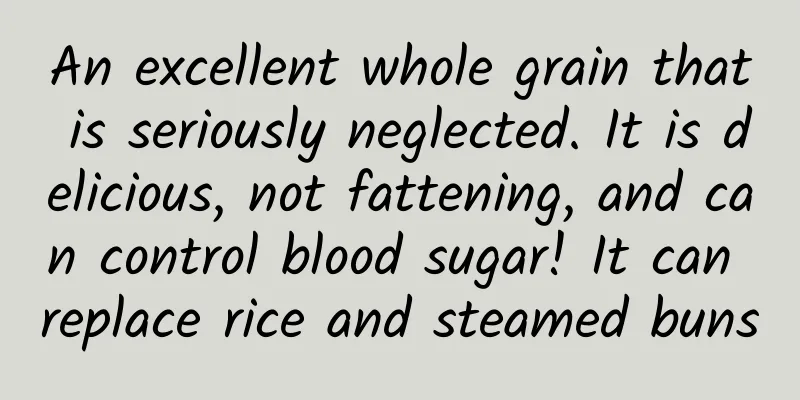An excellent whole grain that is seriously neglected. It is delicious, not fattening, and can control blood sugar! It can replace rice and steamed buns

|
When you mention highland barley, the first things that pop up in your mind are highland barley wine and highland barley tsampa. Although you have heard of them, they seem very far away from our daily diet, like they are the exclusive food of people in Tibetan areas. However, if you miss out on highland barley, you will be missing out on a very good staple food - highland barley can help lower blood sugar and blood lipids, and is a definitely low-GI food. What is highland barley? Highland barley and barley are originally from the same family. Its scientific name is Hordeum vulgare, and its appearance is very similar to barley. Highland barley has a long history of cultivation in my country. According to research, highland barley was introduced into my country even earlier than the Silk Road. There are records about highland barley in the "Compendium of Materia Medica" and "Yao Xing Kao", such as: "Highland barley is similar to barley, with skin and flesh separated by nature, and is planted west of Qinlong" and "Highland barley and yellow barley, with kernels exposed on the outside, are planted in Sichuan, Shaanxi, Yunnan, and Guizhou. It tastes salty and can be used to make wine. It is similar to barley, with thin skin and crispy surface, and is relied on as a staple food by people in the southwest." It can be seen that at first, highland barley was not only the main food crop of the Qinghai-Tibet Plateau, but also grown and eaten in Gansu, Qinghai, Sichuan and other places. However, as more food crops were cultivated, highland barley, which tasted relatively rough, gradually withdrew from the menu of the people in the plains, and continued to shine only in the plateau where crops such as wheat, corn and rice could hardly survive. Copyright images in the gallery. Reprinting and using them may lead to copyright disputes. Highland barley is cold-resistant and drought-resistant, and is not picky about oxygen and temperature. It does not mind even if the land is not fertile. It is the highest-altitude food crop in the world. Not only can it thrive on the roof of the world, but it also has a short growth period, high yield and early maturity, and can be harvested twice a year. In the menu of Tibetan friends, there are many ways to eat highland barley. It can be used in dishes after being slightly cooked, or as a daily snack after being fried. The fragrance of the grain can fill the mouth when eaten alone, and it has a unique flavor when mixed with yak yogurt. It can also be made into highland barley wine after fermentation... Highland barley occupies a vital position in the lives of Tibetan people. Sugar Control Expert Excellent grains with superb nutrition In fact, the nutritional value of highland barley is more worthy of attention—— 1. Rich in Beta-Glucan In the "Dietary Guidelines for Adults with Diabetes (2023 Edition)" released by the National Health Commission this year, highland barley is listed as a recommended grain. In the grain industry, highland barley is indeed known as a "sugar control expert". This is mainly due to one of the characteristics of highland barley: it is rich in β-glucan. The average content of β-glucan in different types of highland barley can reach about 5%. Studies have found that the β-glucan content of some highland barley varieties can reach as high as 8.62%, which is slightly higher than that of oats, a well-known β-glucan producer. β-glucan is a soluble dietary fiber that has strong water absorption and adsorption in the intestines and is not easily digested and absorbed by the human body. In other words, it does not generate much calories itself and can also delay the absorption of sugars in the intestines, thereby slowing down the rise in blood sugar after a meal. For this reason, the "glycemic index (GI)" of different types of highland barley does not exceed 40, making it a low-GI staple food (a GI value below 55 is a low-glycemic index food). You should know that the GI of steamed bread is 88, the GI of rice is 80-90, and even the GI of buckwheat steamed bread is 67. The GI value of barley is so low that it can be compared with miscellaneous beans such as red beans, mung beans, and kidney beans (GI value is 20-30). 2. Rich in Resistant Starch For people who want to lose weight, barley is also a very suitable staple food. On the one hand, the presence of a large amount of β-glucan not only inhibits the intestinal absorption of sugars, cholesterol and other substances, but also slows down the emptying of the stomach, thereby prolonging the feeling of fullness and reducing the risk of snacking because of "getting hungry quickly". On the other hand, no less than 1/3 of the starch in highland barley is resistant starch, which further reduces the digestion and absorption rate of highland barley, which is not only helpful for controlling postprandial blood sugar, but also beneficial for weight loss. 3. High calcium and iron content Unlike other grains, highland barley has a very high mineral content, especially iron and calcium. The iron content of highland barley is as high as 40.7mg/100g, which is higher than the iron content of duck blood (30.5mg/100g); the calcium content of highland barley is also astonishingly high at 113mg/100g, which is higher than the 105mg/100g of milk. However, since the iron in highland barley is not divalent iron that is easy for the human body to absorb, and iron and calcium may also be affected by phytic acid, the absorption rate is far lower than that of iron and calcium in animal foods. Nevertheless, considering that the iron and calcium intake of the Chinese population is not sufficient, highland barley is still worth using as an auxiliary way to supplement iron and calcium. What's more, we can also use vitamin C to improve the absorption rate of iron and calcium by pairing highland barley with fresh fruits and vegetables. How to choose and eat highland barley A friend said that he always felt that highland barley was "exclusive" to Tibetans. He didn't know how to choose among the various types of highland barley sold on the market, and he didn't know how to eat it after buying it home. The main thing to consider when choosing highland barley is its color. Highland barley comes in white, black, purple and other varieties. Similar to other plants, the darker the color of the highland barley, the higher the content of anthocyanins and flavonoids in it. Therefore, dark-colored highland barley can be given priority when purchasing. Copyright images in the gallery. Reprinting and using them may lead to copyright disputes. Eating barley is even simpler. It is highly recommended to use it to replace the current refined staple foods such as white rice and white steamed buns, and make it into barley porridge, barley steamed buns, barley noodles, barley bread, etc., and arrange it into daily diet. 1. Barley porridge As long as you have an electric rice cooker, you can cook highland barley porridge. If you are worried that you may not be used to it, you can start with a combination of rice + highland barley + oatmeal. It should be noted that highland barley is a whole grain and requires more water than rice to cook it until it is soft, sticky, fragrant and smooth. Alternatively, soak the washed highland barley in clean water for 2 to 5 hours before cooking the porridge, which can also make the taste better. 2. Barley milk If you like the chewy texture, you can also use steamed highland barley rice as the "ingredient" for milk to make a cup of highland barley milk. Highland barley rice provides a similar taste to the "pearls" in bubble tea, but with low sugar, low fat and high dietary fiber, it is much healthier than the bubble tea in the milk tea shop. 3. Barley noodles, barley steamed buns/bread, sweet dough If you are a good cook, you can also try advanced highland barley delicacies, such as highland barley steamed buns, highland barley noodles, highland barley bread, etc. The method is the same as ordinary steamed buns, noodles and bread, but it is recommended to use wheat flour with it, and pay attention to adjusting the ratio of water when kneading the dough, so that the finished product will be more palatable. As for the highland barley sweet embryo, the process is similar to that of brewing rice wine/laozao, the key is to control the fermentation temperature and time. 4. Fried beef with barley The Tibetan special delicacy of stir-fried beef with highland barley is not difficult to make. Steamed highland barley rice is paired with tender marinated beef tenderloin. You can also add carrot cubes, green peas, etc. to enhance the flavor. Stir-fry scallions, ginger, and garlic in a pan, add beef and stir-fry over high heat for a few minutes until it is 80% cooked, then add highland barley rice, carrot cubes, green peas, etc., stir-fry for a few times until cooked and you can serve! How about it? Such an excellent staple food does not require any cooking skills. Are you eager to try it? References [1] Yang Yuexin. Standard Edition of Chinese Food Composition Table (6th Edition/Volume 1)[M]. Peking University Medical Press, 2018. [2] Xu Fei, Dang Bin, Yang Xijuan. Evaluation of nutritional quality of different highland barley varieties[J]. Journal of Wheat Crops, 2016, 9: 1249-1257. [3] Meng Shengya, Zhang Wenhui, Yu Cuicui. Comparative analysis of grain nutritional quality of 12 Tibetan highland barley varieties (lines)[J]. Barley and Cereal Science, 2019, 36(06): 1-5. [4] Zhou Hong, Zhang Jie, Zhang Wengang, Du Yan, Dang Bin, Yang Xijuan, Hao Jing. Analysis and evaluation of nutrition and active ingredients of Qinghai black barley[J]. Journal of Nuclear Agricultural Sciences, 2021, 35(07): 1609-1618. [5] Hou Dianzhi, Shen Qun. Analysis of nutritional and functional components of 29 types of highland barley in my country[J]. Journal of Chinese Institute of Food Science and Technology, 2020, 20(02): 289-298. [6] Bai Ting, Jin Yulong, Zhu Mingxia. Comprehensive evaluation of nutritional quality of 56 samples of highland barley grains from different regions of the Qinghai-Tibet Plateau[J]. Food Industry Science and Technology, 2018, 39(23): 318-322, 328. This article is a work of Science Popularization China-Starry Sky Project Produced by: Science Popularization Department of China Association for Science and Technology Producer|China Science and Technology Press Co., Ltd., Beijing Zhongke Xinghe Culture Media Co., Ltd. Author: Wang Lu, registered dietitian Review | Ruan Guangfeng, Deputy Director of Kexin Food and Health Information Exchange Center |
<<: The so-called "bold new theory of everything" is a new paradigm? Or a false proposition?
>>: Physical examination tips: What is considered fasting? How long should you be “fasting”?
Recommend
It's time to defend the potato! We've been so misunderstood about it...
Compiled by: Gong Zixin Potatoes are high in star...
World Economic Forum: Top 10 Emerging Technologies for 2021
The World Economic Forum's 10th anniversary e...
Japan can no longer print money? It turns out that prices have increased...
Is Japan no longer able to print money? Next year...
Nintendo's big bet after a decade, but this time the Switch may not win
I still remember that in 2004 and 2006, facing th...
This flower gives scientists a headache! It can also transform into 72 different forms!
"Seventy-two Transformations" is one of...
How to improve the effect of information flow and double the conversion?
We all know that whether it is bidding or informa...
How to develop a user churn operation mechanism?
Based on his own work practice, the author of thi...
What are the promotion strategies used by platforms such as Tencent, Baidu, and Bytedance?
What trends are shown in advertising placement on...
In order to accurately locate the position of flies in the house, he invented the rectangular coordinate system
Produced by: Science Popularization China Produce...
How much does it cost to make an animation mini program in Dingxi?
The main factors affecting the price of mini prog...
Three minefields in titles of new media operations!
I don’t know if you have had similar experiences....
Is it a crime to take taurine?
Recently, the Shanghai Public Security Bureau rep...
Building high-performance enterprise product architecture with Laravel
Using Laravel to build high-performance enterpris...
Are peaches high in iron? Can eating peaches really help you replenish iron?
"Peaches are high in iron, and eating peache...









